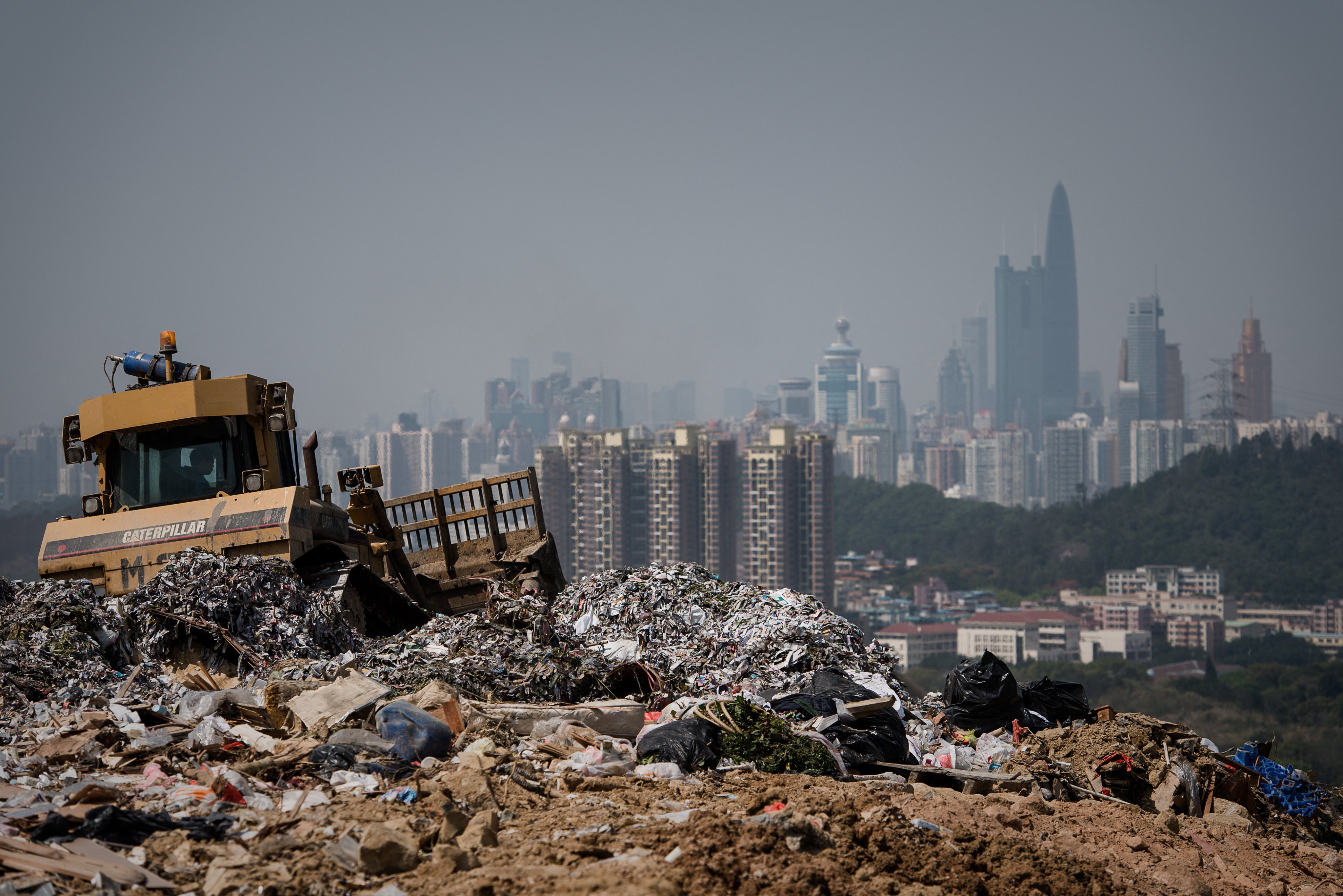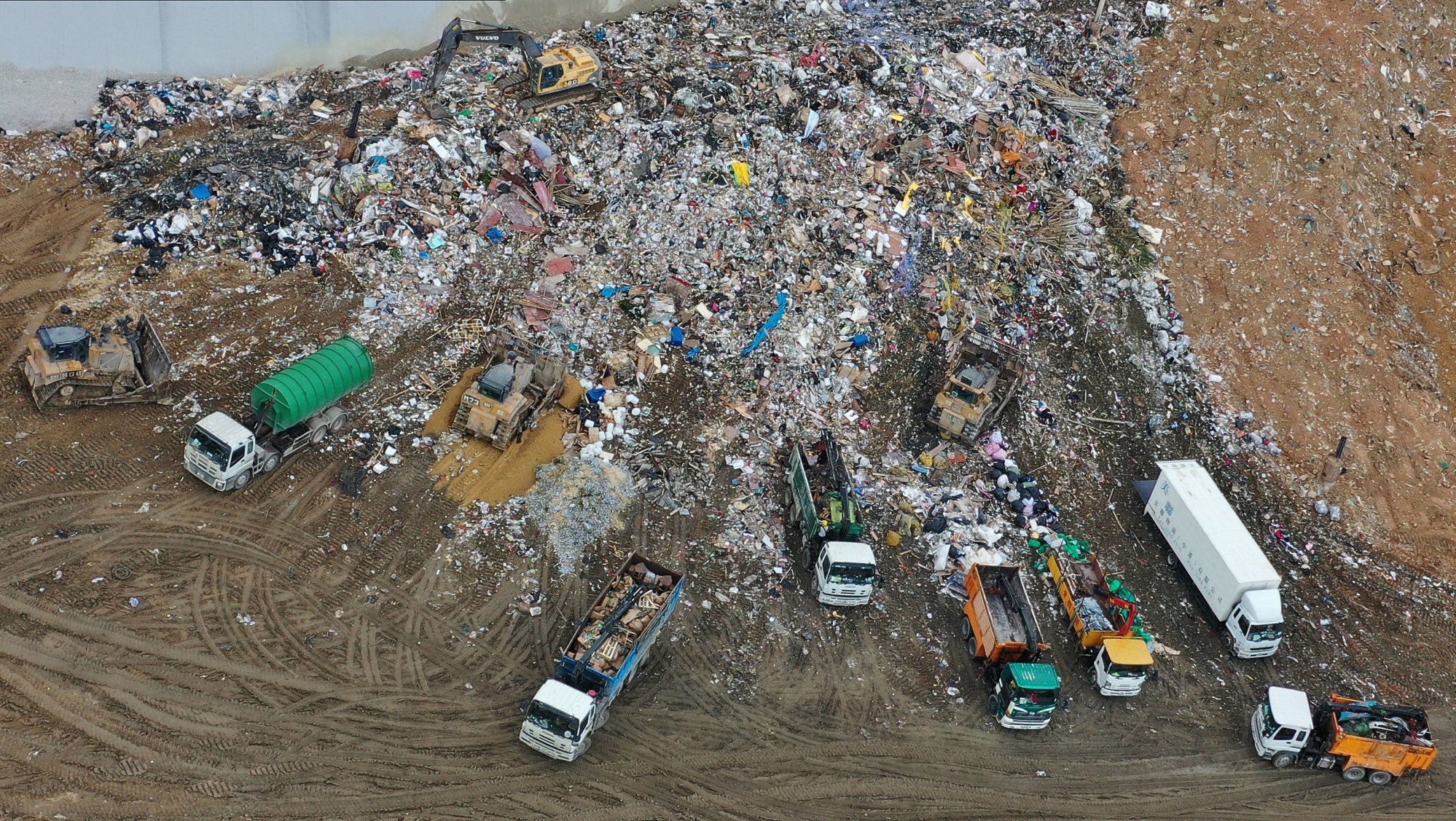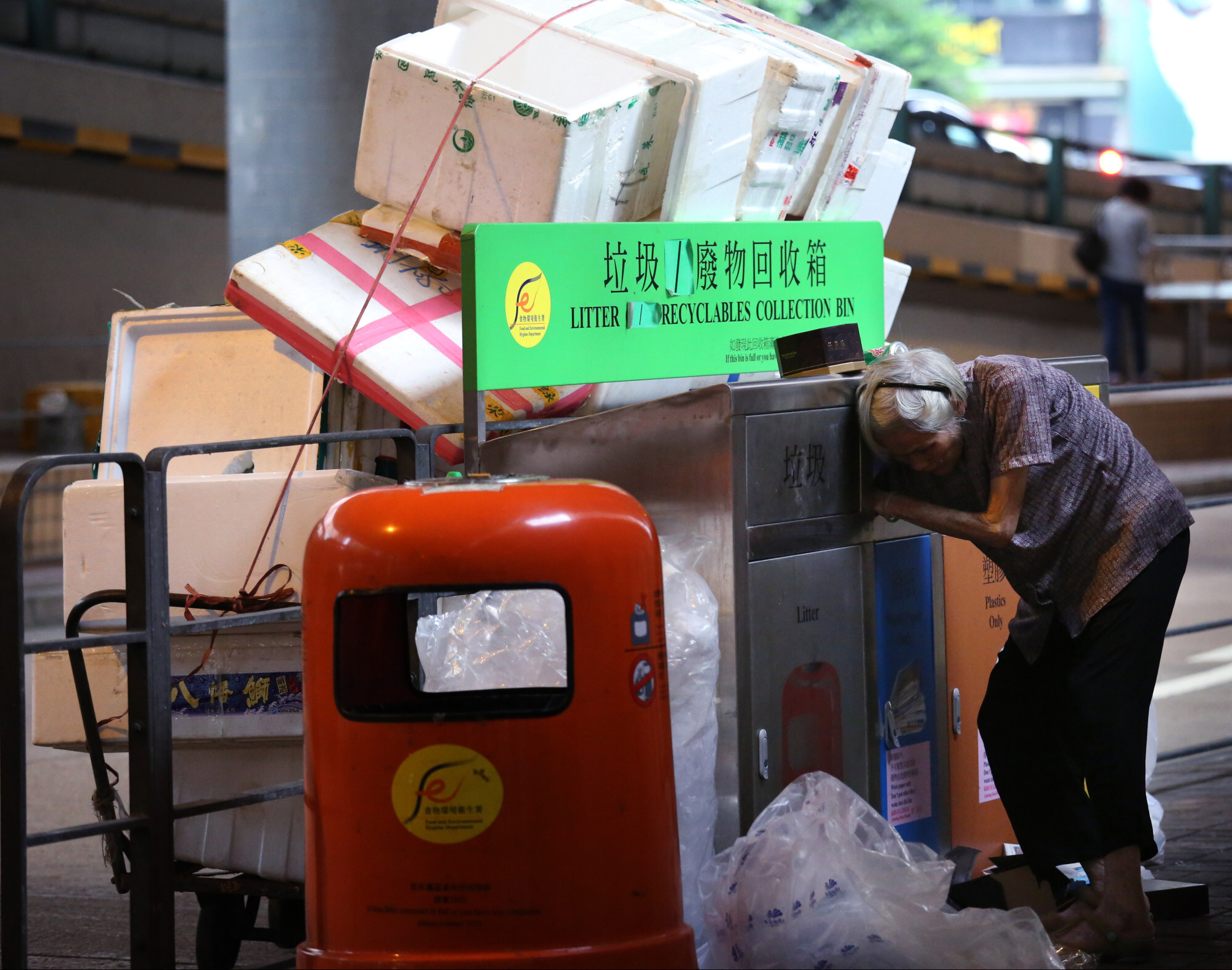
- From collecting rubbish to processing it to persuading people not to create it in the first place, the city lags far behind others in the region
Not long ago, Hong Kong’s rubbish had potential. During the 19th century, it formed the foundation of an ever-expanding metropolis, used in land reclamation or as fertiliser on farms.
Of course, back then our waste consisted of little more than leftovers and scraps, road sweepings, rattan, rags, glass and debris. But that changed in the 1960s.
As the rapidly industrialising city swelled to more than two million people, waste became increasingly toxic, with more plastic waste and industrial sludge. The city needed a landfill.
In 1960, the government opened Gin Drinkers Bay on a harbour in Kwai Chung, where Tanka fishing junks were replaced by deliveries of 3.5 million tonnes of the city’s waste, until the site’s closure in 1979.
What to do about masses of plastic waste from Hong Kong’s hotel quarantine?
As each subsequent decade passed, Hong Kong’s population grew by more than a million. Incinerators came and went, 13 landfills were dug, while three more mega-sized dumps were built, all to absorb the rubbish of an increasingly rich, convenience-oriented society.
Today, landfills teeter on the edge of capacity in Tuen Mun, Tseung Kwan O and Ta Kwu Ling, each accepting, every year, more tonnage than Gin Drinkers Bay’s capacity over its entire existence.

And yet, given the astronomical leaps in technology these same past decades, the story of Hong Kong’s waste has not changed much. It is only voluntarily that paper, plastic, metals and organics are separated at all, and there is limited recycling infrastructure, and little faith in what does exist.
An investigation by news portal HK01 found that nearly two-thirds of housing estates surveyed sent plastic bottles collected for recycling to landfills, and Hong Kong recovered just 230,000 tonnes of its 5.39 million tonnes of solid waste in 2020.
“I think some of the collection systems in Hong Kong are still very nascent, which is why it poses a bit of a challenge to households,” says Ashley Bang, a data scientist at ADM Capital Foundation. Specialising in climate modelling and conservation strategies, she says, “we still have a lot of work to do in terms of thinking about how these systems can be integrated.”

Across Hong Kong, tenement buildings lack waste collection of their own. Communities are left reliant on public refuse points, where huge black bins swell with the community’s contribution to Hong Kong’s 15,000 tonnes of municipal waste per day.
An example can be found on the dimly lit ground floor of Sheung Wan’s cooked food market, where it is almost impossible to differentiate recyclables from municipal waste. Residents could walk a few more minutes to the government’s community recycling network: GREEN@SHEUNG WAN, one of 22 recycling points across Hong Kong’s 18 districts, opened at the end of 2020 with a slick new look – but to little fanfare.
“Already, for an average citizen or consumer to seek out where the nearest station is to them, or what time the mobile recycling station is going to be stopping in their neighbourhood, it’s kind of a large hurdle to overcome,” says Bang. “Hong Kong’s culture of convenience does not necessarily bode well for these types of systems that are not yet very accessible, or well known to the public.
“Whenever I’ve told people about the GREEN@COMMUNITY recycling network, nobody has ever heard of it. I think that’s testament to not only the infrastructural requirements to improve circular waste management strategies, but also the amount of community engagement and communication that is almost equally pivotal to making this happen.”

But collecting rubbish is just the tip of the iceberg. Hong Kong lacks the technical capabilities to process much of the city’s waste, and as a result, only 20 per cent was recycled locally in 2020. Most of it was sent to places such as mainland China, Malaysia, Vietnam, Indonesia and the Philippines.
Until 2018, half of the world’s plastic recycling was shipped to China, until Xi Jinping’s government put a stop to the practice. It was China’s National Sword policy that banned the import of 24 categories of scrap materials, including low-grade plastics and unsorted mixed paper, leaving the burden with individual regions.
Elsewhere, international treaties such as the Basel Convention have limited the movement of toxic waste between nations. A 2019 amendment signed by 187 countries, one that reflected grave concerns around plastic waste, gave nations the power to block the import of contaminated or hard-to-recycle plastic trash.
We are very slow compared to the rest of the region. We don’t have a very good recycling system like Japan, we don’t have a very good waste-charging system like Taiwan, or internationally, we don’t have strong policies like the European UnionEdmond Lau Shiu-long, senior project officer, The Green Earth
In Hong Kong, there are about 2,000 private recyclers, middlemen who carry out the dirty part of the trade: collecting and sorting the materials from other countries, then exporting them to be processed elsewhere. But few have the size or scale to drive industrial change and make recycling profitable, especially now that they are being forced to invest in expensive equipment, while leases on the land on which they operate remain short-lived.
“These factories are very closely guarded and very competitive,” says Eric Swinton, the founder of social enterprise V Cycle, which tackles Hong Kong’s environmental issues by creating dignified work for the underprivileged through materials collection and recycling. “So they’re not that willing to work with each other.”

In 2019, Hong Kong exported 1.44 million tonnes of recycled material with a total value of HK$5.8 billion (US$744 million), which points to new business opportunities in transforming waste paper into pulp, and waste plastics into good quality raw materials. Yet only large companies have the capacity to take such risks.
Last year, with the support of Swire Coca-Cola, Baguio Waste Management & Recycling and German recycling giant Alba Group, New Life Plastics opened the city’s first advanced, large-scale professional recycling plant in a government-run EcoPark in Tuen Mun. It will process up to 100 tonnes of plastic waste a day and turn it into secondary raw material to be reused in the manufacture of resin products.
“We are very slow compared to the rest of the region,” says Edmond Lau Shiu-long, a senior project officer at environmental group The Green Earth. “We don’t have a very good recycling system like Japan, we don’t have a very good waste-charging system like Taiwan, or internationally, we don’t have strong policies like the European Union, where they said they would ban certain kinds of single-use plastic or the wrapping of fruits and vegetables.”
How a new charging scheme can trash Hong Kong’s massive waste problem
Helga Vanthournout, founder of consultancy firm Wealth of Flows, which helps organisations around the globe set sustainability agendas, explains that Hong Kong has the challenge of being an import-oriented economy and a small market.
“Therefore [we] feel a bit paralysed in terms of what we can impose but it’s not impossible as a society to say, look, we do not want these overpackaged fruits and vegetables coming onto our market because we don’t have the infrastructure right now to deal with it.”

But even with the growing number of compostable or paper-based alternatives, Hong Kong does not yet have the industrial composting infrastructure to deal with them, and few households have the money or space to buy and run an at-home composter.
Compostable packaging is often lined with plastic, which keeps a container leak-proof but cannot be recycled at paper mills. This means it continues to break down under landfill conditions and emit methane, negating the sustainable label under which it was sold.
As products differ in the time they take to decompose, regulating sustainable packaging is next to impossible. This makes it hard for an average F&B operator, who just wants to make the right choice for the environment, to commit to eco-friendly alternatives.

Sustainability is also about changing consumer mindsets. Since the outbreak of severe acute respiratory syndrome (Sars) in 2003, hygiene concerns have meant that, more than just tolerating excess packaging and single-use plastic, consumers actually want it. It is a problem that has been exacerbated during the Covid-19 pandemic, as fears that the coronavirus can be transmitted through surfaces have spurred an even greater rush for single-use plastics.
Demand for face shields, masks, gloves, takeaway food containers and bubble wrap for online shopping have also surged. Personal protective equipment (PPE) is scarring landscapes across the globe, piling up in city parks, streets and on shorelines.
Researchers recently calculated that 193 countries have generated more than eight million tonnes of pandemic-related plastic waste. And Chinese consultancy iiMedia Research reported that the total production of masks in China is expected to have surpassed 100 billion in 2020.

Recycling rates, meanwhile, fell last year. International recyclers told Reuters that their businesses had shrunk by more than 20 per cent in Europe, 50 per cent in parts of Asia and as much as 60 per cent for some firms in the United States.
All the while, Hong Kong is drowning in waste from takeaway meals and drinks. ADM Capital Foundation’s report, “Eat Without Waste”, estimated that in 2019, almost four billion single-use food and drink containers were used in Hong Kong, and a large majority of those were hot-food containers.
Hospitality groups and delivery platforms experienced up to 50 per cent more takeaway orders in 2020, the first year of lockdowns and restrictions – a lasting legacy as people rely on the convenience of ordering in and restaurants adapt to the takeaway model.

But plastic and other single-use items are just one part of Hong Kong’s per capita waste, which is dominated by dense food waste. This organic waste doesn’t just smell when it is sent to landfills, it becomes poisonous. Starved of oxygen, decomposing organics release methane, a greenhouse gas.
The government’s 2035 Waste Blueprint pins its hopes on two main initiatives for the future of waste disposal. The first is a municipal waste charge, which would force locals to pay about 11 HK cents per litre of rubbish collected, to encourage people to recycle more and consume less; the second is a new HK$10 billion mega-incinerator under construction on an artificial island south of Shek Kwu Chau, near Lantau.
Aside from the long delays, during which the only things being recycled are ideas from a decade ago, green groups are even less thrilled about the new incineration plant, which threatens the island’s biodiversity. The economics of incinerators can be challenging, too, because to recover costs, waste volume needs to be consistent for the next 20 to 25 years.

With the waste-charging policy and the expansion of recycling programmes, it stands to reason that less waste will be generated, which could mean the Lantau incinerator will have to compete with the city’s own recycling programmes or import waste from elsewhere to remain cost-effective.
The waste charge is less controversial. It is hoped that it will follow the South Korean model, which in the late 1990s saw the waste-disposal rate fall by 40 per cent in just a few years while recycling increased to 60 per cent.
In 2006 the country, which once recycled just 2 per cent of its food waste, made it illegal to send food to landfills. Residents must pay for their leftovers, which become compost, animal feed or biofuel. Today, 95 per cent of South Korea’s food waste is recycled.
In bringing us the greatest health emergency of a lifetime, Covid-19 has highlighted our climate emergency, which offers an opportunity for a smart recovery.
With a three-week quarantine upon return effectively preventing people from travelling out of Hong Kong, The Green Earth’s Lau has also seen “a very big change in how people see our home”. It is not about “just earning money and spending money but also cherishing the land, helping each other – it is about loving your neighbour.”

